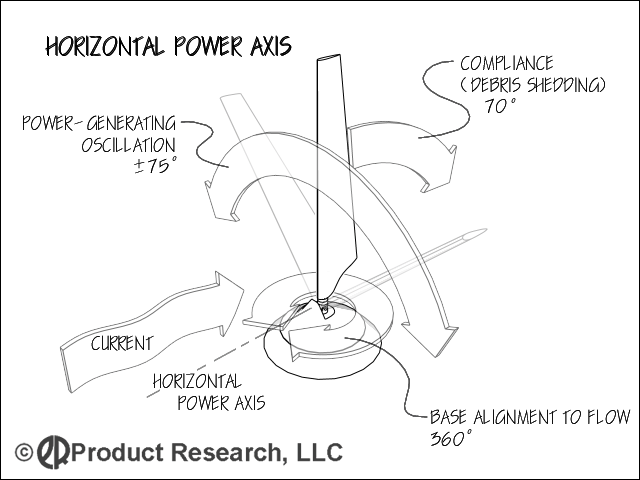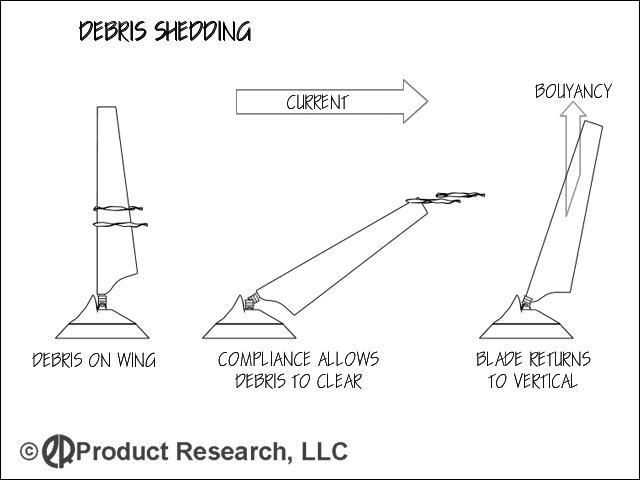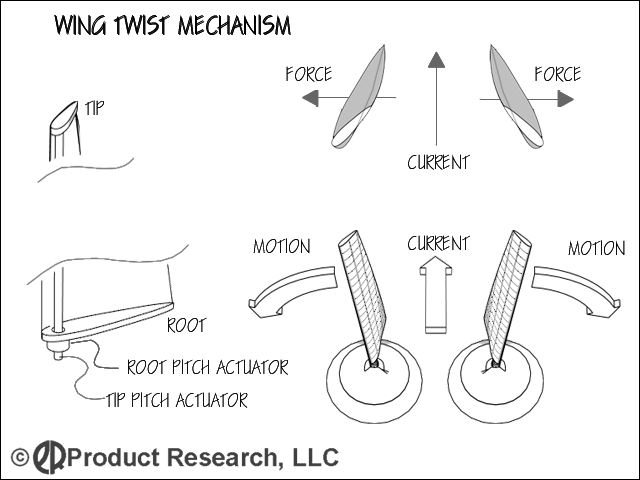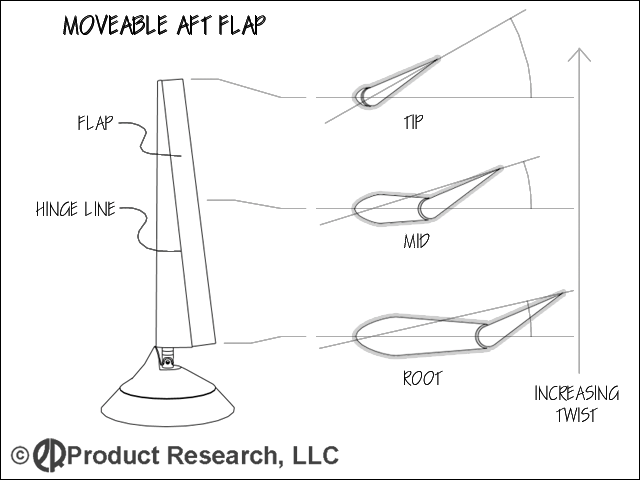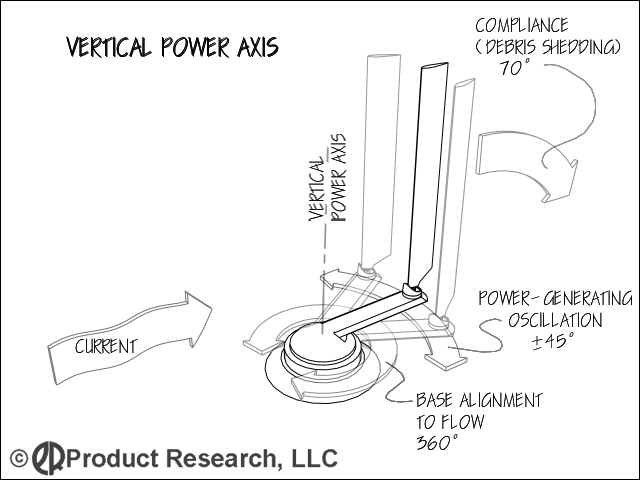 Buoyant Blade Free Stream Tidal Power. Our patent 7,839,009 is for sale. Please contact PR Product Research, LLC. Summary Free Stream Tidal Power, including the power in river flow, is generating interest as a renewable power source. Current approaches use designs adapted from windmills to harvest the power in the moving water flow. These “water-windmills” are not well adapted to the marine environment and present significant problems once they leave the theoretical world. A better solution is provided, taking two forms. The first form is similar to a canoeist in a moving boat sticking her paddle straight down into the water. If she twists the handle of her paddle the blade of the paddle is acted on by the moving water, pulling the paddle to one side. By holding her upper hand still and alternately twisting the paddle blade left and right, the paddle will pull from side to side, rotating around her hand. Everyone has performed a similar task by holding their hand out the window of a moving car. As you twist your wrist, your hand is pulled up and down by the actions of the wind stream. Get the Flash Player to see this player. The second form of the new approach is more like a wakeboarder being towed behind a boat. As the wakeboarder changes the angle of his board relative to the water stream, he is alternatively pulled back and forth across the wake. He rotates around the point where the rope attaches to the boat. Get the Flash Player to see this player. In either form, the new approach keeps the single blade vertical in the current stream using the blade’s own buoyancy. A hinge at the base allows the blade to deflect and “shrug off” kelp or other debris, eliminating the requirement for a huge foundation, mounting pole, or guy wires. The use of a freely mounted, buoyant blade also allows the blade to pivot and safely unload during extremely high currents, protecting the structure while still generating power. Background Please refer to http://en.wikipedia.org/wiki/Tidal_power for a good overview of the current state of the art. Another excellent industry overview from the Snohomish County (WA) PUD is here: http://www.snopud.com/Content/External/Documents/tidal/TidalPres11_13_07.pdf Why is this approach needed? As seawater sloshes in and out of inlets under the influence of the moon’s gravitational pull, currents are created. These water currents contain substantial amounts of kinetic energy that can be harvested at predictable times to provide power, usually in the form of electricity. River flows are also potential sources of “tidal” power. Tidal or riverine currents are often low-density power sources, flowing at 3-5 knots or less. This makes the power difficult to extract efficiently. Hydroelectric dams and their coastal cousins the barrage plants amplify the energy density of the water and then harvest the energy using high-pressure, high-velocity turbines. In the process they modify the environment they utilize, often displacing or destroying native ecosystems. Free-stream turbines have been proposed or deployed that are designed using modern windmill concepts. These “water-windmills” are installed in high-current areas to take advantage of the higher energy density. High current areas are typically “choke points” with lots of marine/riverine mammal, fish, and boat traffic. They are also, in the case of tidal power, highly variable, with reversing currents running from zero to 15 knots or more. It is very difficult to design a turbine to be efficient or even effective in such a variable environment. In many areas water flows carry debris such as fishing nets and fishing lines, kelp fronds or stalks (which can be extremely tough and entangling), boat anchors and anchor lines, and deadheads and other floating wood. This debris can not only clog or jam the mechanism of a water-windmill, but can build up on the structure or anchoring system significantly increasing the load on the foundation and requiring complicated intervention using divers or underwater vehicles to correct. It is even conceivable that a large water-windmill could snag a small boat’s anchor line or fishing nets and pull it under the water. Water-windmills are usually designed with high Reynolds number, high-efficiency blades. The blades are long and thin, with sharp leading edges. They rotate at fairly high speeds(relative to the marine environment and the animals that live there) with high tip velocities causing damage to either the turbine blade or the struck object in the event of a collision. If the struck object is a small tree (deadhead), only monetary damage is sustained. If the struck object is a whale or a school of migrating salmon, the carnage and subsequent adverse publicity could easily destroy the local tidal power industry. If a free-stream tidal plant were to cause significant ecological damage, even perceived damage, it would be subject to eco-terrorism and “monkey-wrenching”. Water-windmills would be extremely easy to damage or destroy. Buoy-hung chains launched elsewhere that follow the current into the turbine area will become entangled, requiring difficult servicing or equipment replacement. Even if a site is chosen that has little or no existing marine life, the very existence of the power plant will create an artificial reef. Various installations(offshore oil rigs, for example) around the world have shown that artificial structure in a “desolate” underwater location soon creates its own local ecosystem. Filter feeders growing on the foundation and moving parts attract small predatory fish and crabs, eddies and current upsets attract migratory animals, and larger species will soon follow. Power generation installations must be sensitive to all affected marine life, even attracted by the system itself. A solution is proposed that provides for the extraction of power from flows away from choke points that is not overly susceptible to fouling from debris and that minimizes damage or deleterious effects to the surrounding environment and ecosystem. In addition, the “normal” requirements for low maintenance in an extremely hostile environment and overall cost effectiveness still apply and are addressed. Key Concept: Impedance Matching Impedance Matching is an involved design approach that comes from electrical engineering. In very simple form, it says that if you have a small load you get the most efficiency using a small matched power source. In our case, it means that if you have a large, slow moving stream of dense fluid, the best way to extract energy is to use a large, slow moving device that exploits the density of the fluid. Another use of the concept is that if you must coexist and interact with large, slow moving marine mammals your device should be of a similar scale and speed to minimize damage to the animals or your device. What is the New Approach? Horizontal Power Axis Parallel to Flow Stream.
The blade is more of an oscillating wing than a propeller blade. It moves slowly, generating little parasitic drag but huge amounts of torque. That torque is harvested at the root of the blade using conventional means such as a directly coupled generator, a gearbox/generator or hydraulic motor/generator. Of course, an alternator could be used instead of a generator.
The blade’s buoyancy opposes torque once the blade passes vertical and heads down toward the sea floor, but that torque returns to the system as the twist in the blade is reversed and the blade heads back to again pass through vertical. In fact, the buoyancy force helps slow the blade as it approaches reversal and also helps accelerate the blade as it begins moving in the opposite direction. The blade sweeps through approximately 90-160 degrees. Vertical Power Axis at Right Angles to Flow Stream.
This configuration is similar to the BioPower Systems bioSTREAM approach(http://www.biopowersystems.com/briefs/bioSTREAM_Technology_Brief.pdf), but our buoyant blade and associated features greatly reduce the structural requirements on the foundation. Debris buildup and fouling is reduced or eliminated by removing the mounting pole. System Deployment and Maintenance In single units, or in small installations such as cabin power from a stream or small river, a system is “installed” by dropping a complete unit into a suitable spot and running the electrical cables or hydraulic tether to shore where the power would be used. The system will land on its base, self-orient, and begin producing power immediately. Retrieving the same smaller system for re-deployment or servicing would be as easy as lifting it by its power tether. Larger systems are installed by locating and placing the base/foundations on the sea floor, then running power and communication infrastructure to each location. Base/foundations contain docking station(s) for the power generating equipment. “Powerheads” containing all the moving and service parts are then winched down to each base/foundation, where they self-orient and are available for power generation. A variable-buoyancy feature would also be useful in this operation. For servicing, the blade/powerhead could be simply released from the base. It would float to the surface for retrieval. For installation, its buoyancy would be minimized so that it would naturally sink or be only slightly buoyant, so a light tether would be enough to lead it into its base. 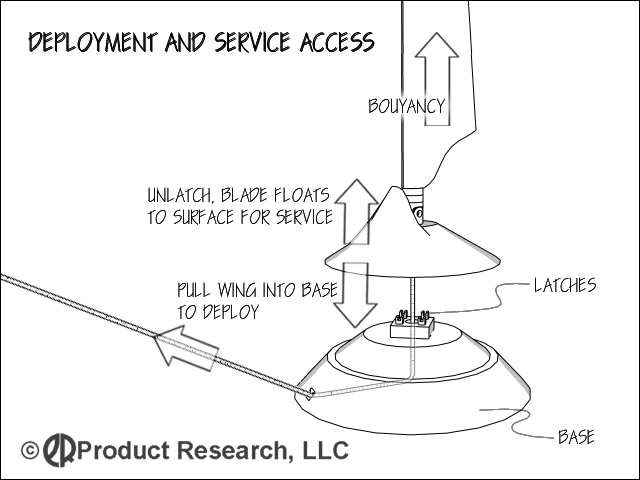
Although it is possible for the larger units to be self-contained and “dumb”, it’s more likely that larger installations will be fully instrumented for both data gathering purposes as well as constant operational optimization(for instance, measure torque as the blade moves one way, and then compare it to the torque as the blade moves the other way. If they are not equal, re-orient the device to balance the torques. Other process variables such as blade twist and pitch can also be varied continuously to insure that we are operating at the maximum power generation level for the highly variable conditions as tide changes or river current eddies). The data gathering parts and pieces may be contained in the power heads, but communicate through the base infrastructure. Blade/powerheads connect to the base using wet contacts, hydraulic fittings, or inductive couplings in the case of direct electrical generation. Base connections can be back-purged with fresh water or benign protective fluids after coupling. It may be possible to use the immersive fluid as the working fluid in a hydraulic/electric system. For instance, in a river installation, river water can be pumped by the system to a shore-based power station. In seawater, corrosion and biofouling can cause many problems. It may be possible to eliminate bio-fouling issues by treating (sterilizing) the seawater working fluid stream before use with an electrolytic cell. Corrosion concerns would remain. The working fluid would be simply returned to the body of water or used for a secondary use such as irrigation. In some instances the device may be more useful as an irrigation pump, with electrical power generation a secondary benefit. Efficiency? Is this new configuration efficient? What portion of the energy in the current stream does the device harvest? At this point, we don’t know. However, these are not the right questions. There are many more low-current, large-area tidal or riverine current sites than there are high current “choke points”. It is important to find a way to tap into the flow energy of these low-impact areas so that the existing activities (human and otherwise) in the choke points are not degraded. A successful tidal power solution must minimize risk to the overall environment, the local ecosystem, the installed equipment, the managing entity, and the general public. Tidal power cannot extract a significant portion of the energy of the current stream without changing the nature of the current. More efficient single devices will simply have to be more widely spaced. Highly efficient power extractors, closely placed, will simply block or divert current flow and destroy the resource they are trying to exploit. Ultimately, return-on-investment and power cost compared to alternatives is the correct evaluation criteria. Assigning environmental and sociological costs to all power options to allow for a complete comparison is the most complex part of this analysis. Tidal or current power is a young industry. Pilot plants, temporary installations and simulations will be required to evaluate the resource and the potential ways to exploit that resource. However, even the industries first “baby steps” must be taken with great care to protect both the environment and the future of the industry. Areas of Concern
What’s Next? A small-scale physical prototype and a CFD model (Computational Fluid Dynamics, where a computer program simulates fluid flow and machine movement to investigate performance of the theoretical machine. It is easy to change parameters within the computer model to simulate design and site variable changes) of the prototype are being developed. Once these are completed, the physical prototype will validate and adjust the CFD model, which will then be used to design and guide the building of a demonstration/pilot plant to meet customer requirements. We are also looking for specialty applications that can be addressed directly. PR Product Research, LLC is looking for business and customer partners to proceed with the development of these ideas. Please contact us at . Who? PR Product Research, LLC is a family owned product development firm created in 1999. Phil Rink, the principal of the company, is a Washington State Professional Engineer with ten patents and many other inventions in fields from water purification to aerospace assembly tooling to underwater video equipment to computer games. He is an expert in automated equipment design and once worked for an underwater robotics firm on Vancouver Island in BC, Canada. Nancy Rink, the other partner in the company, is a mechanical engineer experienced in aerospace manufacturing engineering and process control as well as business management. She was once an employee of the month for the Boeing Everett division and was also on the board of the Northwest Marine Trade Association. Both Nancy and Phil draw from extensive contacts in many industries. Both are SCUBA divers and experienced boaters, and Phil is a licensed Marine Captain and private pilot. They live overlooking the tidal power resources of Saratoga Passage in Washington State. Intellectual Property Our patent 7,839,009 is for sale. Please contact PR Product Research, LLC. Credits Our illustrations and animations were created by Bill Nary at www.bladesim.com. Please contact Bill if you need similar work done. He is an experienced mechanical engineer with an artistic streak that can help you bring your ideas to life through realistic presentation. Copyright: |
||||||||||||||||||||||||||||||||
